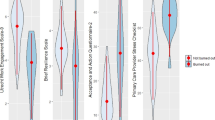Abstract
The aim of this study is to evaluate the prevalence of burnout syndrome among obstetrics and gynecology residents, as well as the relationship between several demographic and work-related characteristics and the prevalence of burnout. We surveyed 143 residents in obstetrics and gynecology programs across eight provinces in Canada using an electronic survey questionnaire and the Maslach Burnout Inventory Human services survey. The prevalence of high emotional exhaustion was 12.6 % higher among younger than older residents and 12.4 % higher among female compared to male residents. The prevalence of high depersonalization was13.0 % higher among male versus female residents. The prevalence of high emotional exhaustion among residents who reported sufficient supervision during the night shift was significantly lower than among those who reported insufficient supervision (95 % CI −49.7, −8.6). Additionally, we found that adequate access to food during the night shift was associated with a lower prevalence of any burnout (95 % CI −31.8, −0.2). Similar associations were observed for high emotional exhaustion and high depersonalization. We also found a 22.1 % (95 % CI −60.0, 15.7) lower prevalence of emotional exhaustion among residents who work 60 h/week or less. Our results suggest decreased levels of burnout in resident physicians who reported sufficient staff supervision, adequate access to food during the night shift, and fewer working hours. Future studies should be directed to examine the effectiveness of different strategies to improve the residency training in obstetrics and gynecology.
Similar content being viewed by others
References
Lund KJ, Alvero R, Teal SB (2004) Resident job satisfaction: will 80 hours make a difference? Am J Obstet Gynecol 191:1805–1810
Dewa CS, Loong D, Bonato S, Thanh NX, Jacobs P (2014) How does burnout affect physician productivity? A systematic literature review. BMC Health Serv Res 14:325
Becker JL, Milad MP, Klock SC (2006) Burnout, depression, and career satisfaction: cross-sectional study of obstetrics and gynecology residents. Am J Obstet Gynecol 195:1444–1449
Castelo-Branco C, Figueras F, Eixarch E, Quereda F, Cancelo MJ, Gonzalez S et al (2007) Stress symptoms and burnout in obstetrics and gynaecology residents. BJOG 114:94–98
Thomas NK (2004) Resident burnout. JAMA 292:2880–2889
Christina M, Jackson SE, Leiter MP (1996) Maslach Burnout Inventory Manual. Third ed. Consulting Psychologists Press, Mind Garden
Afzal KI, Khan FM, Mulla Z, Akins R, Ledger E, Giordano FL (2010) Primary language and cultural background as factors in resident burnout in medical specialties: a study in a bilingual US city. South Med J 103:607–615
Shanafelt TD, Bradley KA, Wipf JE, Back AL (2002) Burnout and self-reported patient care in an internal medicine residency program. Ann Int Med 136:358–367
Brensilver JM, Smith L, Lyttle CS (1998) Impact of the Libby Zion case on graduate medical education in internal medicine. Mount Sinai J Med 65:296–300
Ahmed N, Devitt KS, Keshet I, Spicer J, Imrie K, Feldman L et al (2014) A systematic review of the effects of resident duty hour restrictions in surgery: impact on resident wellness, training, and patient outcomes. Annals Surg 259:1041–1053
Masterson MF, Shrichand P, Maniate JM (2014) Resident duty hours in Canada: a survey and national statement. BMC Med Educ 14(1):S9
Fédération des médecins résidents du Québec, collective agreement (2010–2015) Call schedule and Duty. Article 12
Cohen JS, Patten S (2005) Well-being in residency training: a survey examining resident physician satisfaction both within and outside of residency training and mental health in Alberta. BMC Med Educ 5:21
Legassie J, Zibrowski EM, Goldszmidt MA (2008) Measuring resident well-being: impostorism and burnout syndrome in residency. J Gen Int Med 23:1090–1094
Kleijweg JH, Verbraak MJ, Van Dijk MK (2013) The clinical utility of the Maslach Burnout Inventory in a clinical population. Psychol Asses 25:435–441
White RP, Royston AMW (2011) Multiple imputation using chained equations: issues and guidance for practice. . Statistics in Medicine 377–99.
R core team. R: a language and environment for statistical computing (2014). R Foundation for Statistical computing, Vienna, Austria. Available from: http://www.R-project.org/. Accessed May 2, 2015.
Garza JA, Schneider KM, Promecene P, Monga M (2004) Burnout in residency: a statewide study. South Med J 97:1171–1173
Hussey MA, Hughes JP (2007) Design and analysis of stepped wedge cluster randomization trials. Contemp Clin Trials 28:182–191
Marshall SW (2007) power for test of interaction: effect of raising the type I error rate. Epidemiol Perspect Innov
Acknowledgments
We would like to thank the program directors of Obstetrics and Gynecology, coordinators, and participating residents for their cooperation in this study. Special acknowledgement is given to Alessandra Celani, the residency program coordinator at McGill University for her assistance in distributing our survey to all Canadian residency programs.
Author information
Authors and Affiliations
Corresponding author
Ethics declarations
Conflict of interest
Drs. Al-Mamari and Naimi have no conflict of interest
Dr. Tulandi is an advisor for Actavis Inc.
Additional information
Condensation: Decreased levels of burnout in residents with sufficient staff supervision, adequate access to food during the night shift, and fewer working hours.
Electronic supplementary material
Below is the link to the electronic supplementary material.
ESM 1
(PDF 229 kb)
Rights and permissions
About this article
Cite this article
Al-Ma’mari, N.O., Naimi, A.I. & Tulandi, T. Prevalence and predictors of burnout among obstetrics and gynecology residents in Canada. Gynecol Surg 13, 323–327 (2016). https://doi.org/10.1007/s10397-016-0955-3
Received:
Accepted:
Published:
Issue Date:
DOI: https://doi.org/10.1007/s10397-016-0955-3




